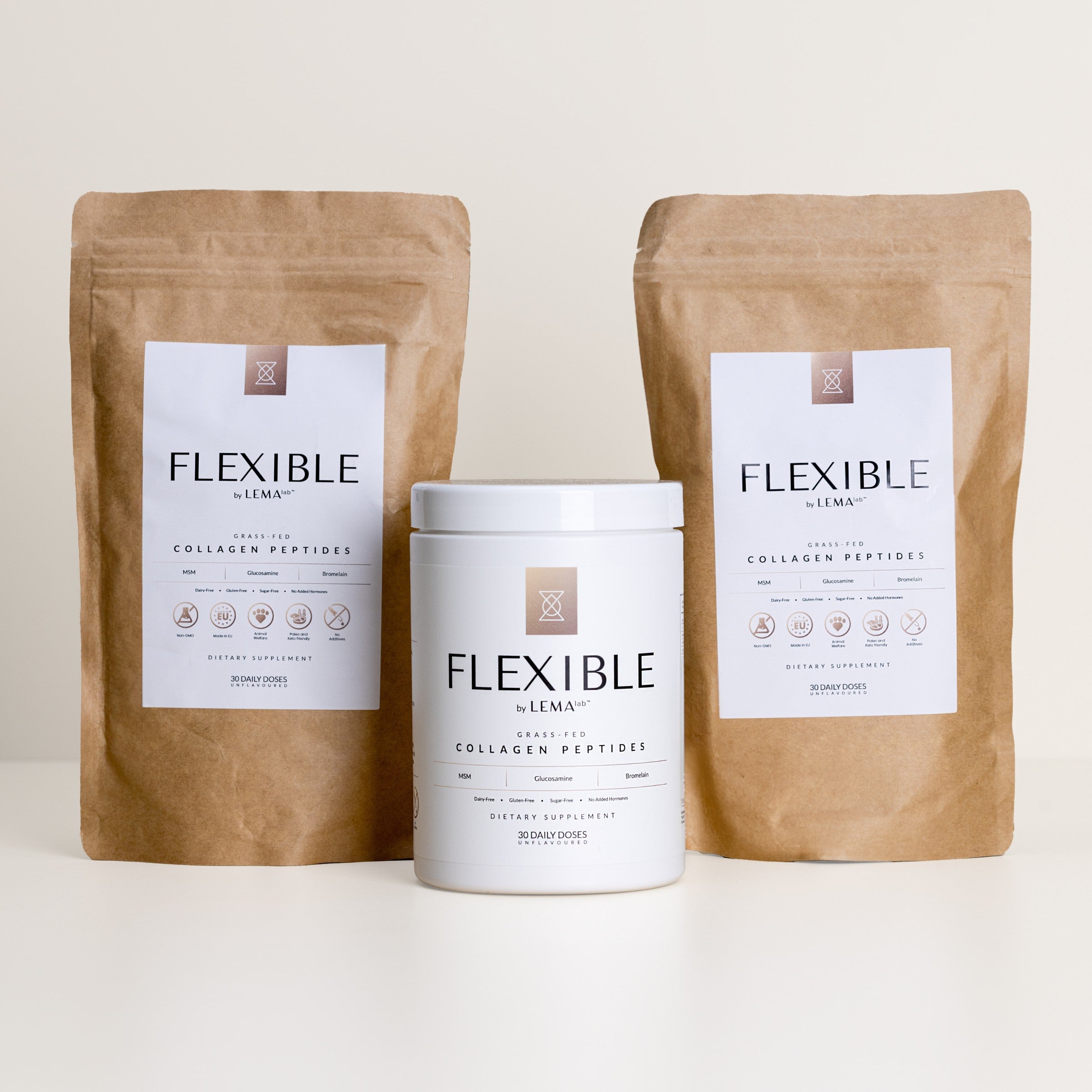
UNDERSTANDING GLYCATION: A CULPRIT IN AGEING TISSUE
Glycation is a natural process where sugars in our bodies react with proteins over time, forming complex compounds known as Advanced Glycation End Products (AGEs). As we age, these compounds accumulate in our tissue, and we can begin to see them as spots and wrinkles on our skin. In the long run, they can promote the development of inflammatory diseases such as cardiovascular disease and osteoporosis. The good news is that this process can be influenced by certain dietary and lifestyle choices [1,3].
The focus of this article is on exploring multiple strategies to hinder and slow down glycation within our bodies, supporting the preservation of healthy and youthful tissue.

THE ROLE OF AGEs ON COLLAGEN AND TISSUE DAMAGE
Long-lasting proteins, such as collagen coming into contact with free circulatory glucose, contribute to the formation of AGEs. This glycation process hampers collagen's repair remodelling mechanisms, making it less flexible and more susceptible to ageing [2].
If you'd like to know more about the remodelling process of collagen, go to our articles THE CRUCIAL ROLE OF FASCIA FOR YOUR FLEXIBILITY PART 1 and PART 2.

TIPS FOR PREVENTING GLYCATION
1. Cooking Methods Matter
AGEs are also formed in foods cooked or processed under high-temperature conditions, such as baking, frying, or grilling. An interesting fact is that AGEs are the reason behind the golden-crispy and shiny aspect we see in certain foods, such as oven-cooked turkeys.
To reduce your intake of AGEs, opt for methods like boiling, braising, poaching, simmering, slow cooking, steaming, or stewing. Rely less on high-temperature techniques like broiling, frying, grilling, or roasting.
2. Balance Your Blood Sugar
The global prevalence of prediabetes was 7.3% among adults in 2017, affecting 352.1 million individuals, and is expected to rise to 8.3% by 2045, impacting an estimated 587 million people worldwide. Regional variations reveal higher rates in North America and the Caribbean (15.4%) and Central and South America (10.0%), compared to lower rates in Southeast Asia (3.0%) and Europe (5.5%). It is important to consider that many people with prediabetes can be going about their lives while not being aware of this condition and in the long run, glucose spikes can lead to faster ageing (especially of the skin, by precisely speeding up the glycation process) and contribute to the development of inflammatory diseases [4].
The combination of specific foods to decrease the speed of absorption of carbohydrates is a known and traditional strategy in the treatment of diabetes. However, it has recently been promoted as a strategy to prevent it as well, emphasising the order in which you eat each food on your plate. This involves consuming dietary fibres alongside a meal sequence of protein and/or fat before carbohydrates [6,8].
This strategy can be a particularly handy tool if you routinely eat refined carbohydrates like white bread, pasta and processed sugary snacks. However, for healthy individuals, it is not necessary to obsess over the order of foods but rather to prioritise keeping balance in their meals, trying to always include good protein and fat sources and not constantly snacking on foods that only contain carbohydrates (e.g., bread and jam, sugary cereals and cookies).
3. Mindful Salt Intake
A review of 6 studies with eight sets of data covering 485 subjects found that people with high or normal blood pressure who have low salt consumption for a certain period of time have higher blood glucose levels than those who have normal or high salt consumption. However, there have also been studies showing elevated blood glucose levels in people with high salt consumption. Plus, we know the risks of a higher salt intake go beyond its effect on glucose, increasing the risk of high blood pressure, kidney damage, water retention, and cardiovascular issues, and it can even contribute to conditions like osteoporosis [7].
Considering all this, the recommendation consists of sticking to the maximum suggested amount of salt and not over-restricting it, but at the same time, don't go around carefree about your salt intake. Remember that much of our salt intake is hidden in highly processed foods.
For adults, WHO recommends a limit of 2000 mg/day of sodium (equivalent to less than five g/day salt (just under a teaspoon).
4. Stay Active
We all know staying physically active is always important for overall health, so this is your reminder to do so in order to manage and reduce your risk of diabetes, high blood pressure, and excessive weight gain.
5. Antioxidants Reduce the Formation of AGEs
The consumption of antioxidants in the form of plenty of fruits, vegetables and omega-3s has the capacity to inhibit glycation.
Antioxidants can also play a role in preventing the formation of AGEs during the cooking process. It has been demonstrated that marinating fish, chicken, and other meat using lemon, lime, or vinegar for one hour can reduce AGE formation, make them softer, and enhance their flavour [5].
6. Inhibiting AGE Production with Food Compounds
Certain compounds, including cinnamon, cloves, oregano, allspice, ginger, garlic, α-lipoic acid, carnitine, taurine, carnosine, and benfotiamine, can inhibit the production of AGEs. While there's no dietary solution to eliminate AGEs, these compounds may slow down their effects, offering potential benefits for maintaining youthful skin.

BOTTOM LINE
In summary, as sugars react with proteins over time, AGEs accumulate in our tissue, impacting the ageing process and its visible signs. Strategies to inhibit and/or slow down this process include relying less on high-temperature cooking methods, increasing the intake of antioxidants, sticking to the recommended daily amount of salt and staying physically active. Understanding and implementing these tips can contribute to a healthier lifestyle, preventing excessive glycation and supporting your body's natural ageing process.
If you are planning to apply this on your day to day, you might also benefit from reading our article HOW TO GET RID OF SUGAR CRAVINGS.














Leave a comment
This site is protected by hCaptcha and the hCaptcha Privacy Policy and Terms of Service apply.